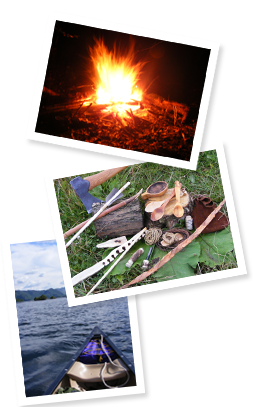Skills and Equipment Glossary
Back to kit & videos
This is our skills and eqipment glossary page. We have created it to help you navigate your way through the pursuit of Bushcraft Survival.
All words in bold link to appropriate pages within and outside of our site.
Amadou – Used to catch a spark from flint/firepiston. Made predominantly from the Horses Hoof fungus (Fomes fomentarius). The light brown 'trama' layer just under the hard outer crust (cuticle) is boiled for 24 hours and then pounded out into a leather-like sheet. To increase the effectiveness of the amadou it can be soaked in a concentrated solution of wood ash or saltpeter.
Arbour – A natural shelter that can give protection from strong sunlight and, if the correct type is selected, heavy downpours. A good example is the dense foliage of a Holly tree (Ilex spp.) which can give good short term shelter from a rain storm, hence its nickname 'the umbrella tree'.
Axe – A powerful cutting tool used to chop through branches, trunks etc as well as to split already cut wood. An axe can also be used when skinning or for separating the outer and inner bark layers of certain trees when making cordage. Click for youtube Videos on willow cordage.
Birch Bark – The outer bark of the birch (Betula spp.) tree has many uses. Due to its high resin content it can be used to light fires even in extremely wet conditions. This can be achieved using either the 'fire steel' or a single match. It is an extremely durable material which is also used to make all manner of useful items, ranging from containers to canoes. If cooked, the bark can even provide you with a thick black oil with numerous craft and medicinal uses.
Bow Drill – A way of lighting a fire by friction. A drill of suitable wood is spun on to a hearth board of a likewise suitable wood using a bow. A top bearing block is used to apply downward pressure. The resulting hot ember is carefully placed into a tinder bundle which is then gently blown into a flame. Click for youtube video of Bow Drill even if its wet!
Coal extender– This enlarges the 'coal' (also referred to as an ember) made during fire by friction or flint striking/fire piston. It consists of very dry and fine/fluffy material which will enlarge the 'coal' and, as a result, increase the chances of successfuly turning the 'coal' into a flame after it is placed in a tinder bundle. This is especially so if the tinder is coarse or slightly damp. Some good coal extenders are: Charred cotton cloth, Cattail down, Amadou, Great Willowherb seed heads, 'punky' wood. On their own coal extenders can actually be difficult to turn into flame.
Cordage – String which can be made from a multitude of natural sources; from nettles and tree barks to roots and tendons. Click for youtube Videos on Willow Cordage.
Debris Hut – A small densely covered shelter made from woodland debris such as leaf litter and strong deadwood branches. If built correctly it can keep a human warm in temperatures as low a minus 40 without a sleeping bag.
Ember- A hot red 'coal' formed from the black dust created during fire by friction methods such as the bow drill and hand drill. This dust is ignited into a smouldering ember by the friction generated heat caused from two wooden surfaces rubbing together. The Ember can be placed into a tinder bundle and blown into a flame. A 'coal extender' (see above) can be used to make small embers larger and thus assist in creating fire when used with coarse tinder bundles.
Click to see youtube video of fires from flint/firepiston/firesteel
Fire Saw - Fire by friction method using woods such as bamboo or yucca to create heat from a sawing action. Method native to South East Asia and certain regions of Australia.
Fire Steel – Made from a mixture of different metals and will produce hot showers of sparks when scraped against hard sharp surfaces such as the back of carbon or high carbon stainless knives or flints and other rocks knapped to a sharp corner. Often comes with a purpose made striker which is usually short so making it difficult to hold firmly – it's worth mounting and lashing these strikers into a section if split wood to provide a more positive grip if you don't use the back of your knife.
Click to see youtube video of fires from flint/firepiston/firesteel
Flint – A glassy rock found in chalky areas. Often forms around a small shell and takes hundreds of years to grow. Can be knapped (struck) with stones and antler to form very sharp cutting edges for knives axes arrow points and scrapers. The sharp edge can also be used to create red sparks when high carbon steel is scraped at speed against it these sparks can be caught by many certain types of tinder to create fire. Iron pyrites can also be struck against the sharp edges but this forms a very cool spark which can only be ignited when using the most perfect of tinders such as buffed and scraped amadou.
Floating- A method of using the hand drill to light fire by friction. It enables very short drills to be used as a pivot is placed in the movement of the hand which results in being able to apply downward pressure whilst enabling the hands to remain in one fixed point on the drill shaft. With practice the user can even climb up the drill shaft whilst applying a firm downward pressure.
Click to see youtube video of floating hands from Dale.
Hand Drill – More simple and lighter way of making fire by friction. It uses a straight long thin drill spun between the palms whilst pressing down onto a hearth. A good combination is elder on clematis. A more tricky technique to master but far more simple and addictive once mastered. Click for youtube video of Hand Drill.
Harpoon- A type of fishing spear which is thrown and can have more than one point on the head. A Leister spear is a thrusting version of this which can be used in rocky or deep water; having attachments which hold the fish in place so removing the need to pin the fish to the muddy bottom. Many spears or harpoons also have barbs to help hold a fish in place.
Fire Piston – A form of creating a burning coal by using compression ignition. Consists of two main parts; a block of hardwood with a hole drilled into it, a rod of equal length to the hole mounted onto a striking end. The rod is forced into the block thus igniting tinder placed into the a small depression in the end. A gasket wound around the end of the rod creates a good seal. Will work if it gets wet.
Puritabs - A small tablet placed in water to purify it of all organisms that caouls give rise to illness. They do not remove chemicaal from the water; in fact they add to it as most puritabs are made from chlorine.
Ventile - A very tightly woven cotton fabric that is hard wearing and can be made into waterproof garments that are ideal for bushcraft. The fabric works by allowing water to penetrate the fibres causing them to swell and block out all water from entering the inside of the garment. They are lightweight and reisitant to hot sparkes from the fire. see www.west-winds.co.uk
This list is constantly growing... or if there is something you'd like us to add or explain then please get in touch using the contact us form.
Learn Bushcraft's Latest News:
Our latest bushcraft courses now listed with dates.
www.youtube.com bushcraft videos now online; search under learnbushcraft to see some of our skills videos.




